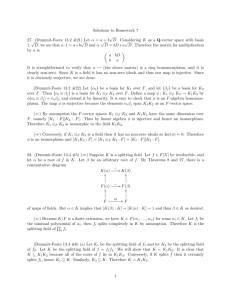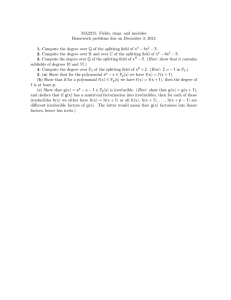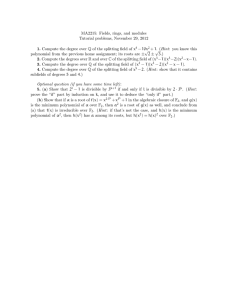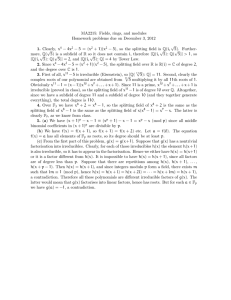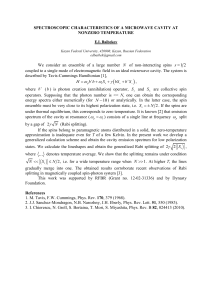Beitr¨ age zur Algebra und Geometrie Contributions to Algebra and Geometry
advertisement
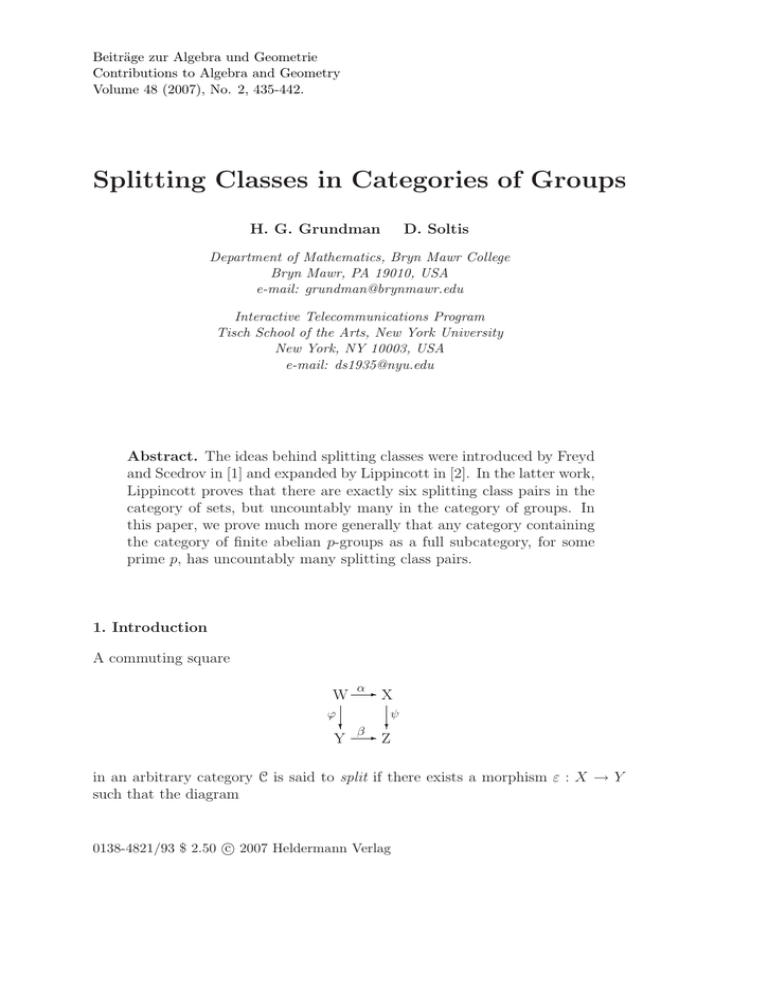
Beiträge zur Algebra und Geometrie
Contributions to Algebra and Geometry
Volume 48 (2007), No. 2, 435-442.
Splitting Classes in Categories of Groups
H. G. Grundman
D. Soltis
Department of Mathematics, Bryn Mawr College
Bryn Mawr, PA 19010, USA
e-mail: grundman@brynmawr.edu
Interactive Telecommunications Program
Tisch School of the Arts, New York University
New York, NY 10003, USA
e-mail: ds1935@nyu.edu
Abstract. The ideas behind splitting classes were introduced by Freyd
and Scedrov in [1] and expanded by Lippincott in [2]. In the latter work,
Lippincott proves that there are exactly six splitting class pairs in the
category of sets, but uncountably many in the category of groups. In
this paper, we prove much more generally that any category containing
the category of finite abelian p-groups as a full subcategory, for some
prime p, has uncountably many splitting class pairs.
1. Introduction
A commuting square
α
W -X
ϕ
ψ
?β
?
Y -Z
in an arbitrary category C is said to split if there exists a morphism ε : X → Y
such that the diagram
c 2007 Heldermann Verlag
0138-4821/93 $ 2.50 436
H. G. Grundman, D. Soltis: Splitting Classes in Categories of Groups
α
W -X
ϕ
ε
?
Y
ψ
?
-Z
β
commutes, in other words, such that εα = ϕ and βε = ψ. (Note: By commuting
square we will always mean one that is oriented, that is, one in which the horizontal
maps and the vertical maps are determined as such.) A morphism α : W → X
splits over β : Y → Z (equivalently, β splits under α) if every commuting square
α
W -X
?
Y
?
βZ
splits.
Following [2], given a class of morphisms A in C, we let A∗ denote the class of all
morphisms that split over all morphisms of A and we let A∗ denote the class of
all morphisms that split under all morphisms of A. It is easy to show that the
sequence obtained by applying these two operators alternately stabilizes after the
first step, that is (A∗ )∗ ∗ = A∗ and (A∗ )∗ ∗ = A∗ . A splitting class pair, T /B is a
pair of classes of morphisms such that T∗ = B and B ∗ = T . In this case, T is
called a top class and B is called a bottom class.
Each of the ∗-operators reverses inclusion on classes of morphisms. Hence the
operators can be viewed as contravariant functors on the category of classes of
morphisms in C with containment as morphisms.
Top and bottom classes always contain all isomorphisms in C and are closed
under composition. Hence, they are subcategories of C.
Splitting classes arise in logic and category theory in results concerning “satisfaction” of Q-trees and diagrammatic sentences. The following two theorems
demonstrate that satisfaction in a given category is closely tied to the splitting
classes there. The first [1] says that morphisms in bottom classes both preserve
and reflect satisfaction of Q-sequences and Q-trees.
Theorem 1. (Freyd, Scedrov) Given a Q-sequence in a class A, then the morphisms in A∗ preserve and reflect satisfaction of the Q-sequence. That is, if
A0 → A1 → · · · → An is a Q-sequence with all morphisms in A and B → B 0 ∈ A∗
then A0 → B satisfies the Q-sequence if and only if A0 → B → B 0 does so. More
generally, given a Q-tree in a class A, then the morphisms in A∗ preserve and
reflect satisfaction of the Q-tree.
Working instead in the language of diagrammatic sentences (constructs almost
identical to Q-trees), Lippincott [2] proves a partial converse to this theorem in
which the category is slightly restricted.
H. G. Grundman, D. Soltis: Splitting Classes in Categories of Groups
437
Theorem 2. (Lippincott) Let C be a locally small category with finite co-limits.
Let Z be an object and S a set of objects. Let T be a top class of morphisms. If
every diagrammatic sentence with universal arrows in T that is satisfied by every
structure in S is also satisfied by Z, then there is a morphism in T∗ from some
Y ∈ S to Z.
Lippincott developed most of the terminology used herein along with basic properties of splitting morphisms and classes. She also examined the splitting classes
in two specific categories: S, the category of sets and functions, and G, the category of groups and group homomorphisms. Specifically, she proved that there are
exactly six splitting class pairs in S, but uncountably many such pairs in G.
In Section 2, we present these results with brief indications of their proofs.
In Section 3, we prove the main theorem of this work (Theorem 5) that for any
prime p there are uncountably many splitting class pairs in Fp , the category of
finite abelian p-groups. Finally, in Section 4, we extend the results of Theorem 5 to
a wide range of categories of groups and examine the limitations of this extension.
2. Sets and groups
The categories of sets and of groups provide an excellent illustration of the variation in the manifestations of splitting classes. In S there are only six splitting class
pairs while in G there are uncountably many. For details of the proofs indicated
below, see [2].
Theorem 3. (Lippincott) There are exactly six splitting class pairs in S.
Let N = {f |dom f = φ and cod f 6= φ}. The lattice of splitting class pairs in
S is given in Figure 1. It is straightforward to verify that the given classes do
form splitting class pairs. To see that there are no other splitting classes, let T
be an arbitrary top class. Lippincott proves that if T contains any non-injection,
then it contains all surjections; if it contains any non-surjection, then it contains
all injections not in N ; and if it contains any element of N , then it contains all
injections. The result then follows using the fact that top classes are closed under
function composition.
Theorem 4. (Lippincott) There are uncountably many splitting class pairs in G.
Let S be a nonempty set of prime numbers. Consider the two classes
BS = {f |∀a ∈ ker f, ord a ∈
/ S};
TS = {f |f is surjective and ∀H ⊆ ker f,
H / G ⇒ ∃a ∈ ker f − H s.t. ∀p prime (p|ord a ⇒ p ∈ S)}.
Lippincott proves that for each S, TS /BS is a splitting class pair. Since distinct
S yield distinct BS (consider the homomorphisms Z/pZ → {0}), this provides an
uncountable collection of splitting class pairs.
438
H. G. Grundman, D. Soltis: Splitting Classes in Categories of Groups
{functions}/{bijections}
@
{injections}/{surjections}
@
@
({functions}−N ) /({bijections} ∪ N )
@
@
@
@
@
@
({injections}−N ) /({surjections} ∪ N )
{surjections}/{injections}
@
@
@
{bijections}/{functions}
Figure 1. Splitting classes in S
3. Finite abelian p-groups
In this section, we prove that for each prime p there are uncountably many splitting
class pairs in the category of finite abelian p-groups. It is significant to note that
the construction given in the proof of Theorem 4 does not work in Fp since it
depends on there being infinitely many primes dividing the orders of the groups.
The construction given here, however, does hold in the category of groups and
indeed provides an infinite family of uncountable collections of splitting class pairs
in G.
Theorem 5. There are uncountably many splitting class pairs in Fp , for any
prime p.
Proof. Let S be a nonempty set of positive integers. Consider the two classes
BS = {f |∀s ∈ S, ∀y ∈ cod f s.t. ord y ≤ ps , ∃x ∈ f −1 (y) s.t. ord x ≤ ps };
TS = {f |∃ an isomorphism δ : cod f → dom f ⊕ Z/pr1 Z ⊕ · · · ⊕ Z/prk Z,
s.t. ∀i, ri ∈ S and ∀x ∈ dom f, δf (x) = (x, 0, 0, . . . , 0)}
We will show that for each S, TS /BS is a splitting class pair and that each S defines
a distinct pair. Therefore {TS /BS } is an uncountable collection of splitting class
pairs in Fp .
Let S 6= S 0 . Without loss of generality, let r ∈ S 0 − S. Let
S− = {s ∈ S|s < r} and
S+ = {s ∈ S|s > r}.
So S = S− ∪ S+ . Let m = max S− and n = min S+ , if they exist. Define
γ : Z/pm Z ⊕ Z/pn Z → Z/pr Z
H. G. Grundman, D. Soltis: Splitting Classes in Categories of Groups
439
by
γ(1, 0) = pr−m and γ(0, 1) = 1.
(If either m or n does not exist, omit that factor of the domain. The rest of the
proof goes through.)
We first show that γ ∈ BS . Let s ∈ S and let y ∈ cod f with ord y ≤ ps .
If s ∈ S− , then 1 ≤ s ≤ m, and so y is in the subgroup of order pm in Z/pr Z.
But this subgroup is generated by γ(1, 0) with each element of Z/pm Z ⊕ {0}
mapping to an element of the same order. So there is some x ∈ f −1 (y) with ord
x = ord y ≤ ps as desired. Further, if s ∈ S+ , then n ≤ s. But γ is surjective,
since n > r, and every element in the domain has order less than or equal to pn .
Thus for every y ∈ cod f there exists an x ∈ f −1 (y) with ord x ≤ pn ≤ ps . Since
the defining condition of BS is satisfied by each s ∈ S, γ ∈ BS .
Now notice that every element of the preimage of 1 ∈ Z/pr Z is of order pn
which is greater than pr . Hence the defining condition of BS 0 is not satisfied by r
and so γ ∈
/ BS 0 . Therefore γ ∈ BS − BS 0 and hence there are uncountably many
distinct BS ’s.
To see that TS /BS is a splitting class pair, first, let α ∈ TS and β ∈ BS . Let
ϕ and ψ be given such that the diagram
α
W -X
ϕ
?
Y
ψ
?
βZ
commutes. Let δ : X → W ⊕ Z/pr1 Z ⊕ · · · ⊕ Z/prk Z be as in the definition of TS .
For each i, 1 ≤ i ≤ k, let
ei = (0W , 0, 0, . . . , 1, . . . , 0) ∈ W ⊕ Z/pr1 Z ⊕ · · · ⊕ Z/prk Z,
where the 1 is in the i + 1st entry in the k + 1-tuple. Let zi = ψδ −1 (ei ). Note that
since ei is of order pri , zi is of order less than or equal to pri . By the definition of
BS , there exists an element of β −1 (zi ) of order less than or equal to pri . Choose
one such element, yi , for each i.
Define ε0 : W ⊕ Z/pr1 Z ⊕ · · · ⊕ Z/prk Z → Y by ε0 (w, 0, 0, . . . , 0) = ϕ(w) and
0
ε (ei ) = yi . Define ε : X → Y by ε = ε0 δ.
Using ε, we now show that the above square splits. Note that for each w ∈ W ,
εα(w) = ε0 δα(w) = ε0 (w, 0, 0, . . . , 0) = ϕ(w). Let x ∈ X be arbitrary
P and let
0
δ(x) = (w,
n
,
.
.
.
,
n
).
Then
βε(x)
=
βε
(w,
n
,
.
.
.
,
n
)
=
β(ϕ(w)
+
ni yi ) =
k
1
k
P 1
P
−1
−1
−1
ψα(w) + ni zi = ψδ δα(w) + ni (ψδ (ei )) = ψδ (w, n1 , . . . , nk ) = ψ(x). So
εα = ϕ and βε = ψ. Thus α splits over β.
Next, let β : Y → Z split under every element of TS . We will show that β
must be in BS . Let s ∈ S and let z0 ∈ Z be any element of order less than or
equal to ps . Note that the homomorphism {0} → Z/ps Z is in TS and so β splits
under it. Consider the diagram
440
H. G. Grundman, D. Soltis: Splitting Classes in Categories of Groups
{0} - Z/ps Z
ψ
?β
?
Y -Z
in which ψ(1) = z0 . Let ε be a splitting homomorphism for this square. Then
ε(1) is an element of β −1 (z0 ) of order less than or equal to ps . Thus β ∈ BS and
it follows that BS = (TS )∗ .
Finally, suppose that α : W → X splits over every element of BS . We will
show that α must be in TS . Note that the zero map from any group to the trivial
group is in BS . Therefore, the diagram
α
W -X
1W
?
?
W - {0}
splits. Hence, α has a left inverse. Thus there is an isomorphism δ : X → W ⊕ W 0
for some W 0 with δα(w) = (w, 0) for all w ∈ W .
It remains to show that W 0 is of the required form. Let Z/pr Z be a fixed
summand in the expansion of W 0 as a sum of cyclic groups. We show that r ∈ S,
as required.
Suppose that r ∈
/ S. Then γ : Z/pm Z ⊕ Z/pn Z → Z/pr Z, as defined above, is
in BS . Let ψ 0 : W ⊕ W 0 → Z/pr Z be projection onto the fixed summand of W 0 .
Let ψ = ψ 0 δ. Then ψα = 0 and so the diagram
W
α
-X
0
ψ
?
?
γ
Z/pm Z ⊕ Z/pn Z - Z/pr Z
commutes. Again, since α splits over every element of BS , the square splits. But
ψ −1 (1) consists of elements of order pr in X ∼
= W ⊕ W 0 while γ −1 (1) consists of
elements of order pn . Since r < n, there is no possible ε : X → Z/pm Z ⊕ Z/pn Z
with γε = ψ. Thus, contrary to the supposition, r ∈ S and hence W 0 is of the
required form. So α ∈ TS and we have TS = (BS )∗ .
Therefore, {TS /BS |S ⊆ Z+ , S 6= ∅} is an uncountable collection of splitting
class pairs in Fp .
4. Generalization
In this section, we examine extensions and limitations of Theorem 5. We start
with a general lemma about top and bottom classes in full subcategories.
Lemma 6. Given a category C with a full subcategory D, any top (resp. bottom)
class of D is the intersection of a top (resp. bottom) class of C with the class of
morphisms in D.
H. G. Grundman, D. Soltis: Splitting Classes in Categories of Groups
441
Proof. Let T /B be a splitting class pair in D. Let T∗ be the bottom class in C
determined by T . Let (T∗ )∗ be the associated top class in C. It’s easy to verify
that T ⊆ (T∗ )∗ .
Let α be a morphism in D with α ∈ (T∗ )∗ . By definition, every element of B
splits in D under every element of T . Since D is a full subcategory of C, every
element of B also splits in C under every element of T . This means that B ⊆ T∗ .
But then since α ∈ (T∗ )∗ , it splits in C (and hence in D) over every element of B.
Thus α ∈ T .
Therefore T is the intersection of (T∗ )∗ with the class of morphisms in D. The
proof for bottom classes is virtually identical.
Corollary 7. Given a full subcategory D of a category C, C has at least as many
splitting class pairs as does D.
Combining Theorem 5 and Corollary 7, the following is immediate.
Corollary 8. Let p be any prime. There are uncountably many splitting class
pairs in every category in which Fp is a full subcategory.
So there are uncountably many splitting class pairs in the category of finitely
generated groups, the category of 2-groups, the category of abelian groups, etc. In
many of these categories, Theorem 5 actually provides an infinite family (indexed
by p) of uncountable collections of splitting class pairs.
It is important to note that although the result in Theorem 5 generalizes
to a wide range of categories of groups, it certainly does not extend to all such
categories. We illustrate this with the category of groups of exponent 2. The
lattice of splitting class pairs in this category is given in Figure 2. The proof of
the following theorem follows the same reasoning as that of Theorem 3 described
in Section 2.
Theorem 9. There are exactly four splitting class pairs in the category of groups
of exponent 2.
{functions}/{bijections}
@
@
{injections}/{surjections}
@
{surjections}/{injections}
@
@
@
{bijections}/{functions}
Figure 2. Splitting classes in the category of groups of exponent 2
442
H. G. Grundman, D. Soltis: Splitting Classes in Categories of Groups
References
[1] Freyd, P.; Scedrov, A.: Categories, Allegories. North-Holland, Amsterdam
1990.
Zbl
0698.18002
−−−−
−−−−−−−−
[2] Lippincott, L.: Properties preserved by certain classes of morphisms. Preprint.
Received June 26, 2006

